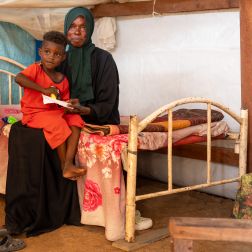- 4 mins read time
- Published: 22nd March 2023
World Water Day - The longest drought on record in East Africa
Last September, we visited Naipa borehole in Turkana County, Northern Kenya, where a solar pump provided precious water to people and livestock in the drought-stricken Horn of Africa.
The lines of thirsty, waiting camels had travelled long distances and their pleasure in finally getting a drink was audible and visible.
Today, we mark World Water Day by highlighting what is now the longest drought on record in East Africa. Long-awaited rains are forecasted to fail this May, making it the sixth consecutive failed rainy season that climate change has brought to the region.
This is unprecedented. In northern Kenya, 95% of water sources have dried up in pastoral areas like Marsabit and Turkana.
Last year we released a report that highlighted how one person is likely to die of hunger every 36 seconds from drought-induced hunger.
Now we must add a new deadly threat - thirst. One in five people in drought-stricken East Africa – a total of 33.5 million people across Ethiopia, Kenya and Somalia – don't have enough safe drinking water.
“The hungriest people in the region are also the thirstiest. People have depleted their last penny as they lost their crops and animals. They now have to pay vendors who continuously hike water prices”, said Fati N’Zi-Hassane, Oxfam in Africa Director.
In some areas in Ethiopia, northern Kenya and Somalia, the cost of water has skyrocketed by 400 percent since January 2021, making remaining water out of reach for the 22.7 million people already facing acute hunger.
Travelling in Northern Kenya last year we drove through a parched landscape, scattered with the remains of dead livestock. The river beds were almost dry but where there was water there were trucks, mostly privately operated, taking water to sell. The situation is the same throughout the region.
“Hundreds of thousands of people are now relying on emergency water trucking, or unprotected wells which are unsafe and contaminated. Without clean water, people are at risk of contracting easily preventable diseases, such as acute watery diarrhoea and cholera”, added N’Zi-Hassane.
In Somalia’s Bay region, where 76,000 people are already facing famine-like conditions, water prices have more than doubled. Families are being forced to make hard choices like selling off what little essential possessions they have left or moving in search of water.
Khadra Omar, a 26-year-old resident from Mogadishu, said, “People are now risking their lives consuming dirty water as a result of the drought. The past droughts were not this bad, we were able to get water but in this one, it has been impossible to get water, everything has dried up and the water that is available is very expensive for us to afford, people are now dying because of thirst”.
While famine has so far been averted in countries like Somalia, mostly due to an increase in humanitarian response – only 20 percent of the UN $7 billion appeal for Ethiopia, Kenya and Somalia has been funded to date, which will derail efforts to help millions of people on the brink.
“The world should not turn its back on East Africa. Without an urgent and major increase in aid, many more people will die of hunger and thirst.
“The worsening hunger crisis in East Africa is a harsh reminder that we also need long-term solutions beyond immediate humanitarian relief, to help people cope with the recurrent shocks. National governments must lead that change by investing in social protection, water infrastructure and supporting food producers,” added N’Zi-Hassane.




